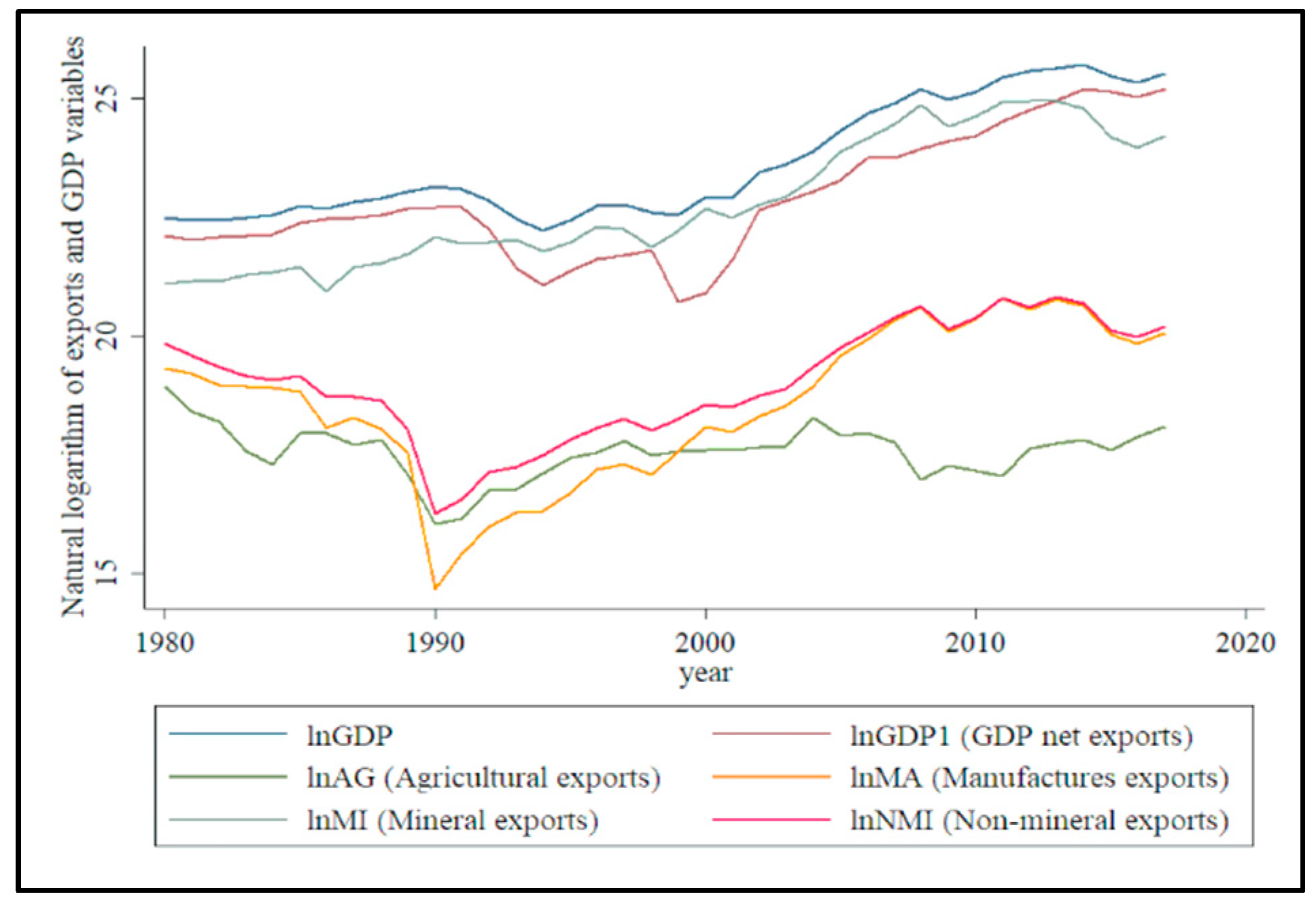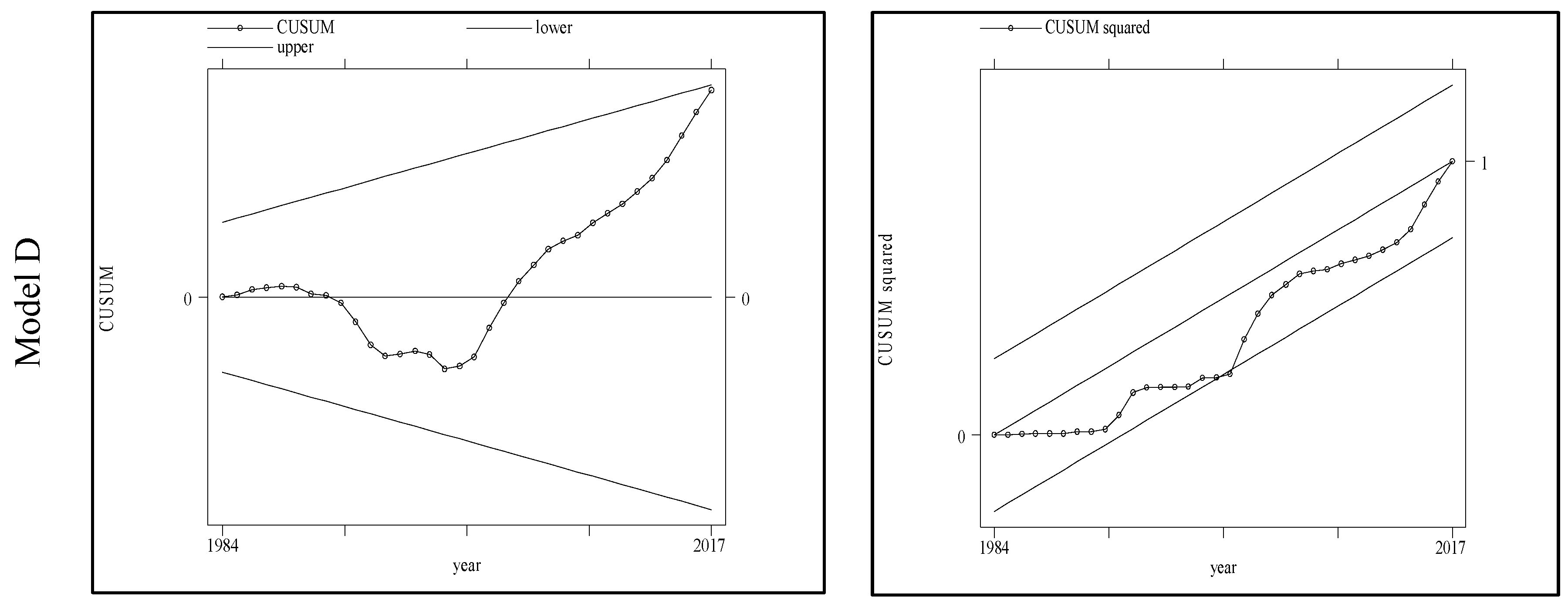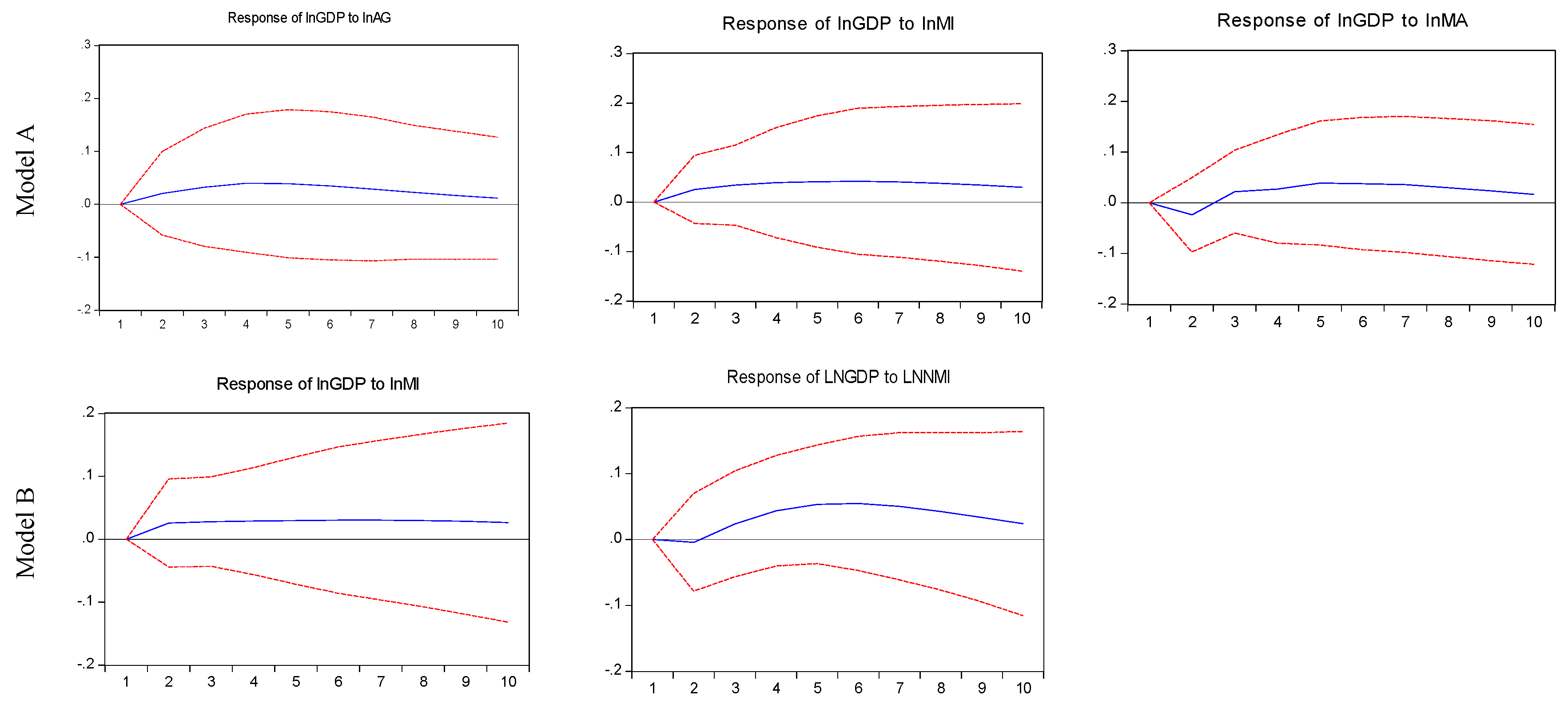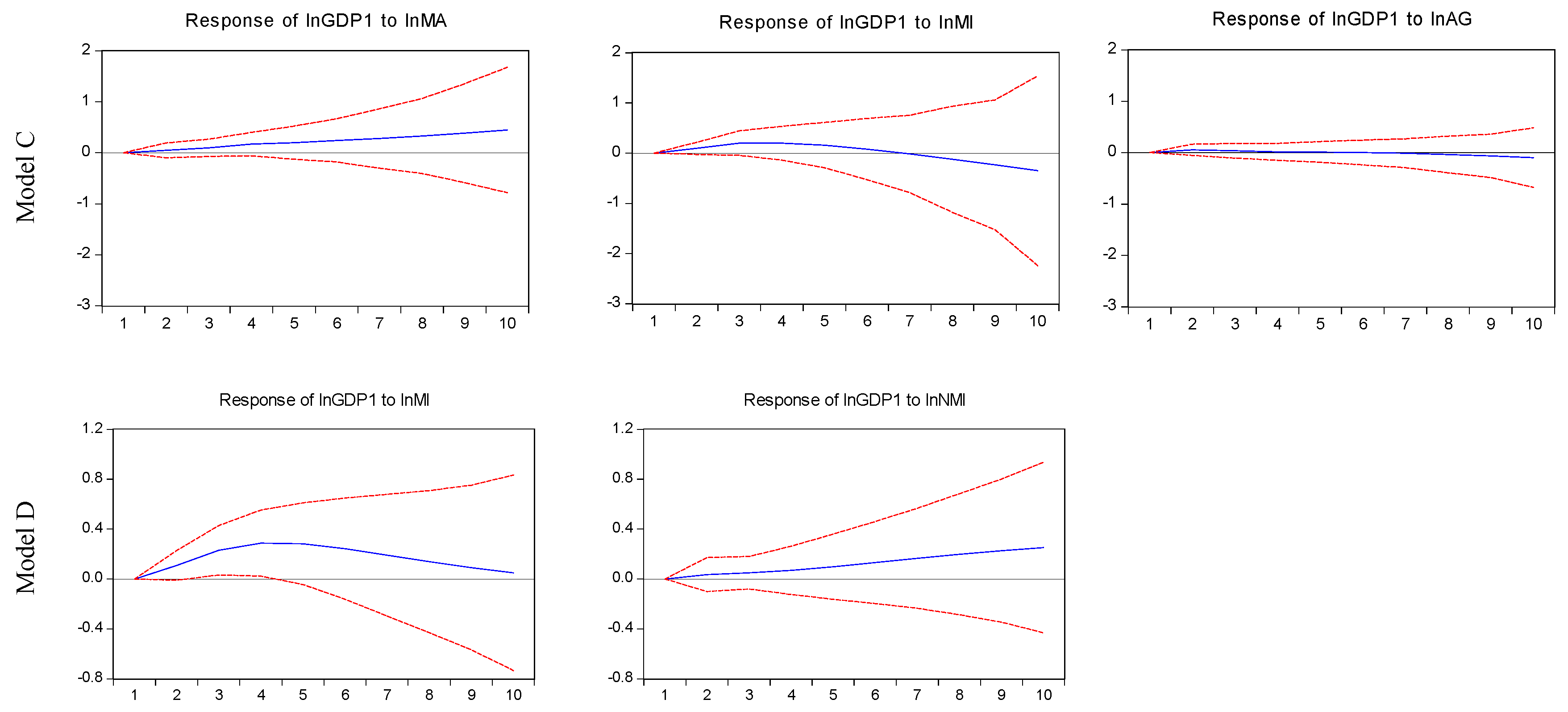1. Introduction
The relationship between exports and economic growth has long been discussed in economic development literature [
1,
2,
3,
4,
5]. When exports have a positive impact on economic growth, the exporting country is said to experience an export-led growth. Published literature indicates that export-led growth is associated with enhanced factor productivity. More specifically, exports stimulate productivity by expanding a country’s market base, through learning by exporting and the diffusion of technology into the exporting country [
6,
7]. Moreover, exports are a major source of foreign exchange required to finance intermediate and capital imports. These are important inputs in production that increase factor productivity [
8]. Exporting also might force the nations to identify their areas of comparative advantage and re-channel their output from less productive sectors to higher productive export sectors [
9]. It is important to note that the extent to which exports impact the economy may vary with the type of commodities exported [
10,
11,
12].
According to the Heckscher–Ohlin model of international trade, a country will benefit by specializing in the production and exportation of those commodities that intensively use the factors of production that the country is abundant in [
13]. According to this theory, labor and natural resource-abundant African countries should export labor- and natural resource-intensive primary commodities and import capital-intensive products [
14]. Empirical support can be drawn from Beny and Cook [
15] who found a positive correlation between natural resources and the economic growth of African countries during the period 1995–2005. Following their comparative advantage, Sub-Saharan Africa’s exports are concentrated in primary commodities because of the abundance of unskilled labor and natural resources [
14,
16,
17].
However, in the case of Sub-Sahara Africa and contrary to the findings for other developing regions, the export-led growth strategies have not resulted in a substantial rise in incomes. More specifically, it is shown that the concentration of Africa’s exports on primary commodities has been associated with negative terms of trade [
18]. On the other hand, the potential for Sub-Sahara African countries (SSA) to gain from exporting exist when they develop an export-oriented manufacturing sector [
19]. A study of manufacturing exporting firms in selected SSA countries shows that exporting firms became more productive, operated at a larger scale, and paid higher wages after they entered the export market as compared to non-exporting firms [
20]. For the majority of the African countries that export their natural resources, economic growth may be unsustainable due to what is known as the Dutch disease. The Dutch disease is an economic term that was introduced by Corden and Neary [
21], and posits a boom in natural resources may lead to a decline in the manufacturing sector through the overshooting of a country’s real exchange rate. As a result, the nation’s non-natural resource exports become more expensive as compared with other countries, and imports become less expensive; making non-natural sectors less competitive [
22]. A rise in natural resource rent can also devastate the political system, which in turn may lead to mismanagement of the natural resources [
23,
24]. Some findings in recent literature have supported the Dutch disease effects on economic growth [
25,
26,
27].
Angola is one of the largest exporters of primary commodities in SSA. If affected by the Dutch disease, the economic situation of Angola can mirror that of a resource–curse-country, where natural resource abundance is associated with deteriorated standards of living [
28,
29]. However, other scholars note that although the Dutch disease has been prevalent in oil-intensive countries, Angola can be an exception because of the positive correlation between oil export intensity and the growth of Angola’s non-oil sectors [
29].
As shown in
Table 1, Angola’s merchandise exports between 1980 and 2017 demonstrate that non-mineral exports, which are composed of agricultural and manufacturing exports, account for a very small share of GDP. Due to the volatility of petroleum prices on the international market, the government of Angola has embarked on economic diversification policies aimed at promoting non-petroleum exports since the end of the civil war in 2002. These policies are aimed at reducing economic dependency on petroleum [
30]. In order to determine appropriate economic diversification policies that are effective in achieving sustainable economic growth in Angola, it is necessary to have a proper understanding of the relationships between macroeconomic variables and economic growth in this rich-petroleum-abundant country. However, surprisingly there are only a few published articles that have examined the effect of exports by sector on the Angolan economy. In order to fill this scientific gap, the current article is aimed at determining the effects of exports of different sectors on the economic growth of Angola. More specifically, this study focuses on the impacts of agricultural, manufacturing, and mineral exports of Angola on its economic growth. Additionally, the second objective of this study is to investigate whether the Dutch disease phenomenon applies to the Angolan economy. This is the first study that measures the impact of Angola’s exports by each sector on its economic growth. The need to understand the effect of non-mineral exports (agricultural and manufacturing), along with the impact of mineral exports, on economic growth is a timely issue as Angola is in the process of implementation of its economic diversification policies.
Source: Calculated by the authors based on data from the World Trade Organization (2019) and World Development Indicators databases of the World Bank (2019). Although the impact of exports by sector on the economic growth of various individual countries has been the focus of several published studies [
31,
32,
33,
34,
35], none have focused on Angola. The exceptions are the two studies by Tekin [
36] and Karamelikli, Akalin, and Arslan [
26]. These studies analyze the relationship between exports and economic growth and include Angola; however, they use panel data. This type of analysis which employs the panel data approach does not necessarily focus on any specific country; but uses the cumulative data from all the included countries to conduct the analysis. More specifically, according to Uk Polo [
37], panel analysis assumes that economic conditions across the countries under consideration are homogenous, which may conceal individual countries’ realities. Our article uniquely contributes to the existing literature as it is the first study that econometrically measures the impact of Angola’s exports by each sector (mineral, agricultural, and manufacturing) on its economic growth as measured by its GDP growth as well as on the growth of its non-export GDP (NXGDP). This study is expected to provide information that could be used by policymakers to help them select policies that can be effective in promoting Angola’s economic growth and economic development. An additional contribution of this study relates to its timeliness, considering the current Angolan government economic diversification plan that emphasizes the promotion of investment and exports of non-petroleum sectors.
The rest of the paper is organized as follows: in the following section, methods and materials are presented. Procedures and empirical data sources are discussed next, followed by the presentation of results and conclusions.
4. Conclusions
The objective of this study is to determine the effects of agricultural, manufacturing, and mineral exports on economic growth in Angola and to test the Dutch disease hypothesis for Angola. The export−led growth hypothesis was used to explain why increasing Angola’s merchandise exports by sector may have varying effects on the country’s economic growth. An autoregressive distributed lag model is estimated to determine the long− as well as short−run effects of the export variables on GDP and non−export GDP (NXGDP), both used as proxies for economic growth.
The results of this study suggest that Angola’s economic growth has largely depended on mineral exports. In addition, to some extent, manufacturing exports are important drivers of economic growth, when total exports are included in Angola’s GDP. Similarly, agricultural exports have greater impacts on non−export GDP growth in the short−run. Moreover, a combination of agricultural exports and manufacturing exports affect Angola’s economic growth positively when exports are included in GDP, and negatively when exports are subtracted from GDP. Furthermore, based on the results of ARDL, it can be concluded that Dutch disease is not confirmed in Angola during the period of the study. This conclusion is drawn from the results that mineral exports are shown as having a positive impact on Angola’s economic growth. This finding is in line with Klein [
17]. These results might imply that Angola is an exception to the phenomenon of resource curse because mineral exports are found to be a major driver of economic growth [
16,
27]. The positive impact of oil revenues on the growth of other economic sectors; in terms of infrastructure, legislation, and policy, may be attributed to many reasons. For example, the proceeds from oil exports have provided adequate financial resources to improve transport infrastructure to the extent that there has been a significant increase in the repair, reconstruction, and construction of roads as a means of enhancing national cohesion. In the area of energy investment, generation capacity has been increased from 830 MW in 2002 to 2230 MW in 2014 [
62]. In terms of the policy, Angola has set a long−term strategy to diminish the import that it has provided a golden opportunity to promote non−oil exports, specifically agricultural exports. This has been done through an import tariff escalation policy. For instance, the tariff on imported agricultural products was increased to 50 percent [
63].
There are several resource−rich countries that have been able to escape the resource curse. Norway and Botswana would be prime examples of this situation, where appropriate institutions and policies have played a critical role in diversifying the economy [
64,
65]. An interesting example of this is the United Arab Emirates (UAE), where a considerable amount from oil revenues have been invested in infrastructures such as airports and roads. The government has made a significant step towards non−dependence on oil revenues, through programs such as the development of tourism, construction, and industry sectors.
According to the results of this study, despite that the non−oil export sector has a positive contribution to economic growth, it is shown that it has a weaker impact on economic growth than the oil exports. The reason for this could be that while Angola has made considerable progress in infrastructure reconstruction and adopting the supporting policies, the gaps remain specifically in the term of the availability of electric power; low levels of skilled labor and the education and productivity of workers; access to adequate credit; and inadequate rural road network. Hence, adopting infrastructure−building policies, such as those aimed at improving the business environment in order to attract more foreign investment in the non−mineral sectors, continuation of infrastructure investments, transfer of technology to those economic sectors that have comparative advantage (such as agriculture); can all play a significant role in economic sustainability and in reducing dependency on oil revenues.











